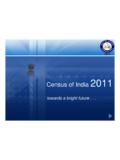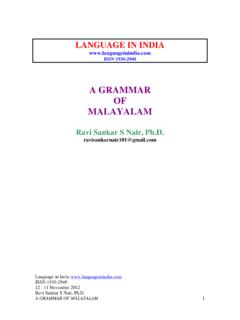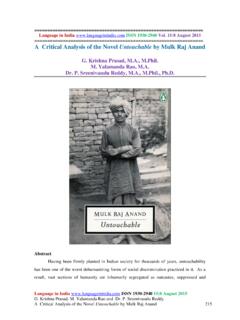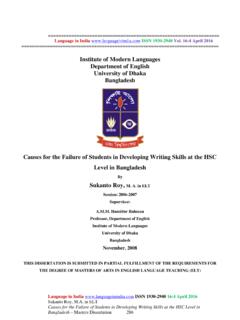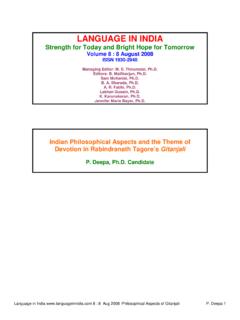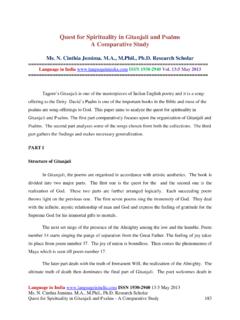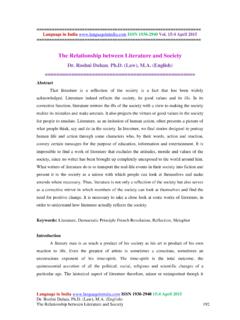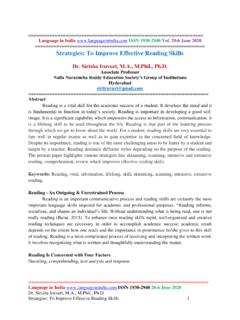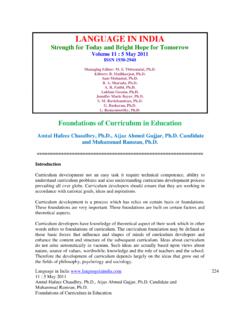Transcription of Challenges and Problems in the Teaching of Grammar
1 Language in India 169 10 : 2 February 2010 Prashant Mishra, , , Challenges and Problems in the Teaching of Grammar LANGUAGE IN INDIA Strength for Today and Bright Hope for Tomorrow Volume 10 : 2 February 2010 ISSN 1930-2940 Managing Editor: M. S. Thirumalai, Editors: B. Mallikarjun, Sam Mohanlal, B. A. Sharada, A. R. Fatihi, Lakhan Gusain, K. Karunakaran, Jennifer Marie Bayer, Challenges and Problems in the Teaching of Grammar Prashant Mishra, , , Abstract Teaching of Grammar has always remained a controversial subject as the method and material adopted in Teaching it. L1 learners learn their mother tongue intuitively but for L2 learners, Teaching of Grammar becomes inevitable in order to acquaint them with the norms of the target language. In the 21st century, so many paradigms Structuralism, Transformational Generative Grammar , Functional Grammar , and Pragmatics etc.
2 Came into existence and bewildered the language teachers with their jargon and hypotheses. A Grammar teacher remains in a state of confusion to decide whether he should follow the old prescriptive approach or the descriptive approach of the Structural Linguists; whether he should aim at the achievement of grammatical competence or communicative competence of the learners; whether he should concentrate on the parts of sentences by parsing them or on the utterances of the speakers; whether a teacher should concentrate in his pedagogy on the Teaching of rules or the correct use of language. The paper attempts to explore the Challenges and Problems faced by a language teacher in the Teaching of Grammar . It is written in the light of the necessity of Grammar Teaching to maintain intelligibility and comprehensibility of the speech of the learners of the second language.
3 Language in India 170 10 : 2 February 2010 Prashant Mishra, , , Challenges and Problems in the Teaching of Grammar Keywords: Grammar , contextualization, socio-cultural situations, structures and forms, communicative competence. Introduction Before initiating a Teaching programme, a teacher must know whether he is going to teach the learners of L1 or L2. In an L1 situation, learners learn their mother tongue intuitively. It is culturally and environmentally inherited by them. The culture or the environment around them becomes their covert teacher that provides them sufficient exposure through which grammatical forms and structures required to use a language correctly and proficiently are naturally transferred to their memory. But when it comes to the learning of a second language and if it is a foreign language, exposure is very limited, artificial and conscious.
4 Learners, therefore, do not feel at home and if not motivated properly feel it an extra burden on them. Even if the L2 learners receive some exposure, it is received not through the native speakers but through those who themselves have learnt the target language as L2. In such a situation, for an effective learning of L2, learning of Grammar becomes very necessary. According to C. Paul Verghese, A knowledge of Grammar is perhaps more important to a second-language learner than to a native speaker. This is because in the process of acquiring the language the native speaker has intuitively internalized the Grammar of the language whereas the second language learner has to make a conscious effort to master those aspects of the language which account for grammaticality. It is, therefore, necessary for us, to whom English is a second language, to learn the Grammar of the language (Verghese1989:41).
5 Hence acquainting the learners of L2 with the correct norms of the target language and providing them practice through creating meaningful situations in the class room becomes necessary. The present paper aims to investigate the various Problems and Challenges faced by a pedagogue in Teaching Grammar effectively to the learners of a second language. Standard of the Students One of the Problems generally faced by most of the teachers of English at the college level is the poor standard of the students. Students are even ignorant of the basic rules and structural patterns which they are supposed to have learnt at the school level. If a teacher directly starts his Teaching at the graduate level without trying to know the level of the students, his efforts will not bear any fruits as he will not be able to raise a structure over a feeble foundation.
6 Language in India 171 10 : 2 February 2010 Prashant Mishra, , , Challenges and Problems in the Teaching of Grammar Therefore, a teacher before starting his Teaching programme must assess the language background of the learners. Keeping in view the background of the learners, he should select his Teaching items, grade them and present them in accordance with the local situations. A teacher should begin from the simple grammatical items and proceed towards the complex ones. Each succeeding grammatical item has to be based on the previous ones taught earlier in the class. Thus, by carefully selecting the frequently recurring grammatical items and by grading them as per the background of the learners, a teacher should provide constant practice to the students in creating and using sentences based on the grammatical forms and structures in various day-today situations of their lives.
7 Problem of Selection of Material for Teaching Forms and Structures One of the Challenges and Problems before the teachers of Grammar is the selection of suitable examples to teach grammatical rules and forms. In the old traditional grammars examples used for illustrating rules are of alien context for the Indian students. According to Professor Sinclair, It is now generally accepted that it is extremely difficult to invent examples which sound realistic, and which have all the features of natural examples. I am convinced that it is essential for a learner of English to learn from actual examples, examples that can be trusted because they have been used in real communication (Sinclair1990: vii). Professor Sinclair regards Train stopped and Frey agreed as genuine examples than Bird sing as real examples have a communicative value that the invented one lacks (Sinclair1990:xi).
8 Many of the examples are taken from old English classics. Many of the sentences used are of poetic and figurative type and do not match the existing communicative needs. Many examples used in Wren and Martin s High School English Grammar and Composition have the literary flavour and do not have any bearing to the native environment of the Indian children. How can our children acquire proficiency in the use of English through these examples which they are unable to understand due to their colonial associations and proverbial nature? Let us look at some of the examples used by Wren and Martin on page numbers 1 and 2 of High School English Grammar and Composition : 1. Humpty Dumpty sat on a wall. 2. Down went the Royal George. 3. Sweet are the uses of adversity. 4. The cackling of geese saved Rome. Language in India 172 10 : 2 February 2010 Prashant Mishra, , , Challenges and Problems in the Teaching of Grammar 5.
9 Tubal Cain was a man of might. 6. Borrowed garments never fit well. 7. The early bird catches the worm. 8. Ascham taught Latin to Queen Elizabeth; 9. All roads lead to Rome. 10. No man can serve two masters. (Wren and Martin1986: 1 and 2). One of the Challenges before a teacher of Grammar is to make the Teaching meaningful and relevant to the needs of the learners by contextualizing it using examples derived from the socio-cultural situations of the learners. But the examples of the above type do not differentiate the Teaching of Grammar from the Teaching of rhetoric. An L2 learner who is ignorant of the archaic and diachronic data of English does not find such type of examples congenial to learning. Since a learner has to use a language in day- today situations of his life, examples drawn from the actual life situations are helpful to him as they relate to real communicative acts and needs.
10 These real examples are natural and easy to learn than the invented ones or the borrowed ones from the literary texts which are alien to the native surroundings of the learners and make the comprehension difficult for the learners. A data based on the current form and socio-cultural situations will interest the learners rather than the archaic and obsolete data borrowed from the old writers. The diachronic data may contribute to grammatical competence but not to the communicative competence which is the ultimate aim of language pedagogy. The traditional grammars mix up the modern English forms and their use with the past conventions and the outdated use of language. The school grammarians push the study of modern English into Anglo-Saxon mould. One of the features of language is change and so we do not need past usage and information to study the present state of language.
